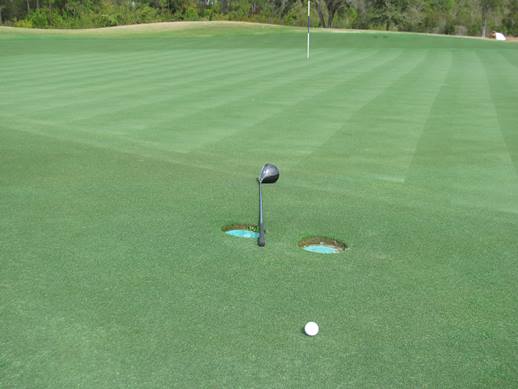 If you have ever played in a tournament conducted by an association, tour, or similar group that conducts multiple tournaments throughout the year, you were probably given a variety of documents either at registration or through email in advance of a tournament. These handouts usually include a hole location sheet, pace of play policy, Local Rules for the day (called a Notice to Players), an evacuation plan for dangerous weather, and a sheet called the Hard Card.
If you have ever played in a tournament conducted by an association, tour, or similar group that conducts multiple tournaments throughout the year, you were probably given a variety of documents either at registration or through email in advance of a tournament. These handouts usually include a hole location sheet, pace of play policy, Local Rules for the day (called a Notice to Players), an evacuation plan for dangerous weather, and a sheet called the Hard Card.
After receiving these documents most players fold them up and shove them into their bag never to be looked at again, with the exception of the hole location sheet. What the players fail to realize is that the two most important documents provided to them are the Notice to Players and the Hard Card. The Notice to Players is a list of the Local Rules that are in effect for that day and on that particular course. Pretty important right?! But, what is a Hard Card???
A Hard Card is a document that lists all of the Local Rules and Conditions of Competitions that are in effect for every event the association or tour conducts. Common items typically found on Hard Cards include; embedded ball through the green, clarification on out of bounds and hazard margins, integral parts of the course, clarification of french drains and fire ant hills, sod seams, and electronic distance measuring devices. Additionally, some Conditions of the Competition are also included on the Hard Card usually including the list of conforming driver heads and golf balls.
The name “Hard Card” is strange isn’t it? Well, years ago most golf associations would print their Hard Card at the beginning of the year on thick hard card stock paper with the hope that players would keep the Hard Card in their bag for the year. The term Hard Card refers to the paper it was printed on and is still common among golf administrators.
The FSGA just released our updated Hard Card for 2018, and there were several additions for this year. Let's take a look at some of the additions:
1. Edging Grooves Around Putting Green: If a ball lies in or on an edging groove around a putting green, or if the groove interferes with the area of the player’s intended swing, the ball may, without penalty, be lifted, cleaned and placed in the nearest position to where it lay that is not nearer the hole and avoids the interference by the condition whether on or off the putting green.
Why: Edging grooves are very common in Florida since the grass on the putting green is normally a different strand than the grass on the fringe and rough. The edging groove helps keep the different grasses from spreading to unwanted areas. When a ball ends up on one these grooves it presents an unfair and very difficult shot, so we feel relief is justified.
2. Obstructions: Stones in bunkers are movable obstructions.
Why: An association conducting a tournament doesn't have the opportunity to check every bunker for stones. It is easy to miss a bunker that contains stones and stones can create a potential danger to players. Allowing players to remove stones in bunkers is a safety measure.
 3. Immovable Obstructions Close to Putting Green: The Local Rule prescribed in Appendix I is in effect. Relief is available only when the ball and immovable obstruction lie in a closely-mown area, the ball lies through the green, and an immovable obstruction on or within two club-lengths of the putting green and within two club-lengths of the ball intervenes on the line of play between the ball and the hole. (Drop the ball at the nearest point of relief, not within one club-length)
3. Immovable Obstructions Close to Putting Green: The Local Rule prescribed in Appendix I is in effect. Relief is available only when the ball and immovable obstruction lie in a closely-mown area, the ball lies through the green, and an immovable obstruction on or within two club-lengths of the putting green and within two club-lengths of the ball intervenes on the line of play between the ball and the hole. (Drop the ball at the nearest point of relief, not within one club-length)
Why: Closely-mown areas around putting greens with sprinkler heads close to the putting green are very common. Many players prefer to play a shot along the ground using a putter or other low lofted club, but these obstructions sometimes prohibit a player from choosing this method of shot. The key to relief is that the obstruction must be within two club-lengths of the putting green and the ball must be within two club-lengths of the obstruction. Also, both must lie in a closely-mown area and the obstruction must lie on the player’s line of play. The ball must be dropped at the nearest point of relief; no additional club-length is allowed.
To view the complete FSGA Hard Card please click here.
Remember, the FSGA Hard Card is only in effect for events conducted by and for the FSGA. The USGA has a slightly different Hard Card for their events and their final copy for 2018 will be released in early February.
Most golf clubs have a version of a Hard Card, but it is usually listed on the scorecard or posted at the club. Knowing the Local Rules and Conditions of Competition that are in effect for each round will help you save strokes!





